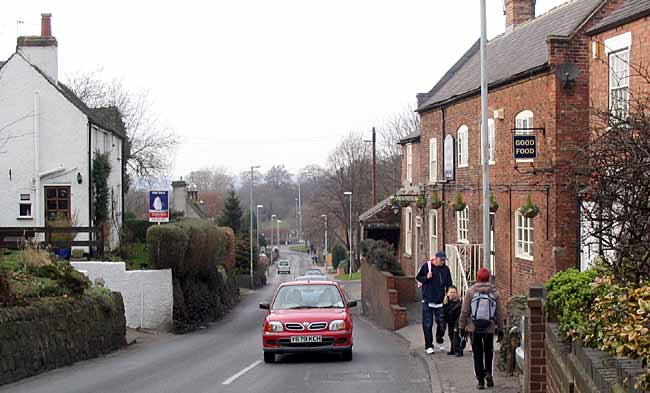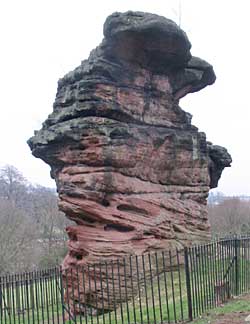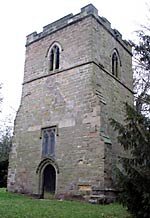Bramcote

Town Street, Bramcote.
The Druidical Associations Of Bramcote

The Hemlock Stone.
"BRAMCOTE," wrote Fyfe in 1856, "has undoubtedly an antiquity of its own, but it is wonderfully immersed in obscurity." Since that time more of its history has been revealed by the opening of various archives, but mystery yet veils its Hemlock Stone which remains, as it has been for ages, a "stone enigma." Standing upon a hill half a mile west of the village this irregularly-shaped rock column, sloping from 30ft. to 50ft. at its overhanging cap, with a girth of about fifty feet at its base, is the nearest approach the county can show to a prehistoric monument, and fancy has played around it in the wildest fashion.
One tradition accounts for its existence by saying that the Devil's slumbers in the Peak were so disturbed by the prayers of a pious monk at Lenton that he hurled a piece of rock to destroy that priory but his aim was short and the fragment remains where it fell. More prosaic, though equally baseless, are the suggestions that the Stone is the hardy survivor of an ancient quarry, or that it takes its name from the profusion of poisonous hemlocks that once flourished around it. "Hummock" and "Cromlech" have failed to convince, and perhaps the most likely solution of the problem is that the same derives from the Danish "Hemmelig" which indicates a cover or something overhanging—an explanation precisely, suitable to the projecting summit of this piece of rock.
A Natural Altar.
Whether the Hemlock Stone was used by the Druids is an open question, but it is certain that they did not make it, for geologists agree that it is a natural formation of sandstone cemented at the top by barium sulphite which has protected its supporting column. Glacial floods have washed away the surrounding earth, but frost, sun, wind and rain, rather than "marine action'' have moulded it to its present shape. It is thus a primeval relic but it is possible that the Druids used it: they may have regarded it as an altar made for them by their gods, and traces of human handiwork in its upper part may represent, their adaptation of it for their sacrifices.
Major A. E. Lawson Lowe has been freely quoted as an authority against any such theory, but in his later life, in his (unpublished) history of this parish, he stated that "we must not without consideration dismiss the tradition which connects the Hemlock Stone with Druidical worship. . . . Its commanding position is just such a one as the Druids would have chosen ... and nothing could be more probable than that they, having found a natural altar so situated, should have adopted it and indeed regarded it with peculiar veneration." All that can be said without reserve is that its position was suitable and that a fair case appears to have been made out for Druidical associations. It is even more probable that its lofty ridge served in ancient times as a toothill or lookout place, for from the upper windows of houses on elevated sites no less than six counties are visible.
Bramcote itself takes its name from the Cytisus Scoparius or common broom (gorse) which was unusually abundant on its sandy soil, but by the 13th century the letter 'a'' had superseded the 'o' element in the name and had come to stay, 'Cote' its suffix, is the Saxon term for a cottage or dwelling, but the time when the earliest settlers founded a village amid the moors on the northern slopes of the valley of the Trent is unknown. The "cotes" would be of wattle and mud, and early Saxon origin has been suggested.
In 1066 there were four manors here, held respectively by Saxon or Danish thegns, Ulchel, Godric, Aleuric and Leuric, but inasmuch as persons so named were then landowners in other parts of the shire it does not necessarily follow that any of them had a hall at Bramcote. Their lands were rated, to the Geld-tax at 60s., but by 1086, when they had all been granted to William Ostiarius (the usher or porter), their value had declined to 20s. Together these manors comprised about 200 acres, and the Norman lord retained to his own use as much of them as could be ploughed by two teams of oxen in a year: the remainder was apparently sterile as also was the much larger outlying territory of the village. The royal manor of Arnold had lands here and William Peverel had a larger portion, soc to Wollaton, which in Domesday is, specifically described as waste.
Azor's Gift.
Within fifty years of the Conquest Azor—who may perhaps be identified with the last Saxon lord of Kimberley—had acquired land here which he gave to Lenton Priory at or soon after its foundation, leaving behind him his curse and that of Almighty God upon any of his heirs who might contest the benefaction, but none the less the priory was not allowed to enjoy it undisturbed. The land pertained to Arnold's share, and Azor's gift apparently lacked the sanction of its lord. Hugh de Nevill, holder of Arnold, accordingly sued the monks and finally confirmed the grant subject to a pension of 12s. a year being paid by the monks for ever to himself and his heirs Sempringham Priory, in Lincolnshire, presently obtained some 400a. soon after its establishment in 1148; the donor (presuming it was a gift) is unknown and it is intriguing to think that it may have been part of the Bramcote estate that the last of the Peverels forfeited when, in 1154, he fled from the wrath of the new king, Henry II.
Under the early Plantagenets the Mortuo Mari (Mortimer) family became the mesne lords of much of the lay soil, which was held of them by the Riseleys, and in 1242 Henry de Birchwood was holding property of the Honour of Alfreton. The Riseley's part passed to the Byleyes and in 1316 the Prior of Sempringham and Robert de Byleye were lords of Bramcote. The Willoughby's also had possessions here which they steadily increased and long retained. Under them, the Karrs, of Ruddington, held a manor which in the reign of Henry VI passed to the Babingtons, of Chilwell, and when William Babington perfected the Martell chantry in Flawford Church, in 1458, part of his endowment consisted of 16 bovates of land and four acres of meadow belonging to that manor. It descended to the Delves and from them to the Lords Sheffield, and in the time of Elizabeth was dispersed among divers freeholders.
Tithe Dispute.

The tower is all that survives of the original Bramcote church.
Meanwhile, a controversy which had lasted 40 years in the court of the King's Bench was determined in 1246 by the arbitration of the Archbishop of York who, to avoid effusion of blood, made peace between Lenton Priory and Sir Rd. Grey who had just succeeded to his father's estates. The dispute concerned the tithes of Attenborough Church, to which the chapelry of Bramcote pertained, and it was agreed that the priory should have tithes to the value of 40s. yearly out of this chapelry, the other moiety was to remain to the Greys, and Lenton was to pay a pound of frankincense every year at Attenborough feast. Later Robert Castelmayne and John de Bramcote with others of this village accused the Prior of Lenton of murder. There had apparently been a fracas in which an inhabitant was killed, but when the case was tried at Beeston the prior was adjudged guiltless.
The Prior of Sempringham was involved, in 1330, in minor trouble for it was then found that he had been punishing offenders against the assize of bread and ale by money fines instead of committing them to the
pillory or tumbril, and his rights being thus imperilled he paid 40s. to retain them. There was also trouble with regard to the Babington chantry for the Rev. Wm. Guile the rector of St. Peter's, at Nottingham, had been vested with the endowment and not until he was compelled did he surrender it. He was probably stickling for some legal formality.
Hunting Feud.
The Records of the Borough of Nottingham tell that in 1433 Hugh Cock of Stapleford sued Henry Fisher as surety for the township of Bramcote for 4s. 8d. due for service as the village swineherd. Fisher denied liability and as nothing further is heard of it the case was probably settled out of court. More exciting were the local events connected with the feud between Lord Lisle and Sir Henry Willoughby about 1480. His lordship accused the owner of Wollaton of hunting on land belonging to his park: Willoughby declared that it was waste land; blows were exchanged and a man was shot by an arrow and died. Lisle, eager for revenge, sent a gang of between 40 and 50 armed men to waylay Sir Henry on Bramcote Hills. That ambush failed, but six months later the attempt was repeated, and 100 armed men lay here while one of their number carried a cartel of defiance to Wollaton Old Hall. Willoughby did not accept the challenge and his lady was so affrighted by these fearsome visits that she became bedridden. How these foes were ultimately reconciled was related in the recent article on Bradmore.
